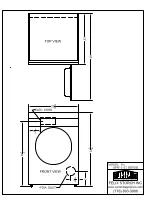
HUGH CRANE (Cleaning Equipment) Ltd
–
COMMANDO
®
1000 Range BARROW UNIT
J\Engineering\Manuals\COMMANDO MANUALS UPDATE2017Manual Commando 1000Range_Update2017
- 16 -
j)
When air free water is issuing from the bleed hose turn the three-way valve to the
high-pressure position.
k)
Now operate the wash gun to bleed air out of the hose until air free water is issuing
from the lance.
l) Increase the engine speed to the desired working level, using the hand throttle lever at
the side of unit. Use of the throttle will directly affect output water volume and
pressure.
7.2 DURING WORK
:
a)
Do not leave the COMMANDO unit idling for periods in excess of 15 minutes, as
re-circulating water heats up rapidly and will eventually boil causing severe
damage to the pump.
b)
Should any vibration, fluctuation of pressure or any other abnormal symptoms occur
during operation, this should be investigated immediately.
Likely causes include:-
i)
A lack of water entering the unit causing air to be drawn into the pump.
ii)
A blockage of the main inlet filter causing water starvation at the pump.
iii)
The inlet water valve between tanks and pump not fully open.
iv)
Leaking seals or damaged valves etc.
7.3 DETERGENT/CHEMICAL ADDITION.
a)
The unit can be equipped for chemical addition by adding an in-line chemical or foam
injector.
b)
The suction pipe and filter of this injector should be inserted into the detergent drum,
which can be located immediately adjacent to the
Commando
®
unit. The amount of
detergent can be regulated to suit the task by rotating the black knob on top of the
detergent injector. Rotate anticlockwise to increase the dose, clockwise to reduce and
fully shut off.
c)
Any chemical used must be suitable for the task and used in a manner so as not to
endanger the operator or others, or cause damage to the machine. To this end:
- Only detergents/chemicals approved by Hugh Crane Cleaning Equipment should be
used
- The task and detergent/chemical must be subject to a full COSHH assessment prior
to commencement, with all necessary precautions put in place.
d)
Following use of any chemical the machine should be flushed through with clean
water to remove any residues, with flushings directed to a safe location where no
environmental harm will be caused.










































